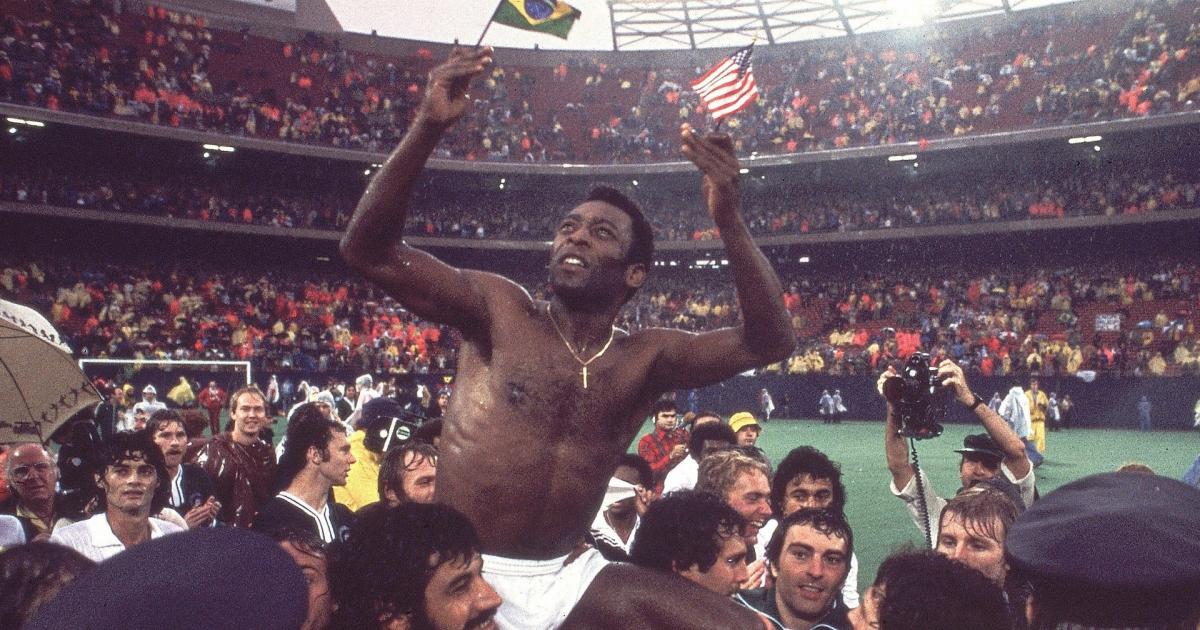
It is tempting to suggest Pele’s impact on America was that of a revolutionary force in the same manner as Elvis’: astonishing talent, inescapable charisma, unsurpassed achievement, no last name necessary.
Except Elvis came along in the 1950s and almost immediately forced rock & roll into every American household that had a teenager. Pele, during his career and in the years after, was so extraordinary he became a star in a nation that was decades from embracing his sport. He was a revered and beloved artist in a wholly unpopular art form. To Americans who didn’t know Johan Cruyff from Johannes Brahms, Pele was an undeniable superstar.
Eventually, that mattered. His appeal gradually helped to spread the gospel of the game from New York to LA and in between and undoubtedly helped lead to the 1994 World Cup being placed here, to the resurrection of the pro game through Major League Soccer two years later and to the astonishing soccer boom that now allows fans of the sport to watch leagues from England, Spain, Italy and Mexico on their televisions or devices.
“I am surprised. Every place I go, people love me. But that’s what we need in this country,” Pele told the Baltimore Sun in 1993, meaning more enthusiasm for soccer generally. “And we must make space for the younger players.
PELE IN TSN’s ARCHIVES: Sept. 11, 1976 issue | Oct. 29, 1977 issue
“Everybody knows how hard I fought to bring the World Cup here to the U.S. when I played for the New York Cosmos. A lot of U.S. papers and reporters teased me. But now my dream has come true, and hopefully the U.S. will develop a strong league. In the old league, they gave too much space to foreigners and ignored the younger players.”
Had there been no Pele on American soil, it’s likely there never would have been a David Beckham or Thierry Henry, and, more important, possibly never a Landon Donovan or Christian Pulisic.
U.S. Soccer Hall of Famer John Harkes has said he gave up his other sports interests and concentrated on soccer after serving as a ballboy for the Cosmos and becoming fascinated by Pele and the team’s other greats. Goalkeeper Tony Meola, also a Hall of Famer, has said serving as a Cosmos ballboy allowed him to watch his first pro game. Both from North Jersey, they were members of the 1990 squad that broke a 40-year World Cup drought for the United States men’s national team. The U.S. did not miss another World Cup for 28 years.
It’s hard for younger Americans who see that soccer is ubiquitous on television now to understand how absent the sport was during the 1970s and 1980s. The North American Soccer League existed, but it struggled in most markets and almost never appeared on national television. There were entire seasons with one or two national broadcasts. There was a PBS program that ran from 1976-88 called “Soccer Made in Germany”, an hour-long abbreviation of Bundesliga and other pro games. Not every public TV station was interested.
FARRELL: Remembering Pele, the man who taught the world the beautiful game
One was highly unlikely to encounter coverage in the magazines that might be read by a sports-obsessed teen, from The Sporting News to Sport to Sports Illustrated. And on those rare occasions when one did, like when Sport ran a piece on Cruyff and “Total Football,” we chose to turn the page. The material was indecipherable. We never saw the game, so we knew nothing about the rules, tactics and techniques. As one can see presently from the attitude many Americans still carry toward the game, part of our sporting culture was to loathe soccer.
Pele, though, we understood. His smile and charm were irresistible. American Express put him in one of their “Don’t Leave Home Without It” ads, and they wrote it so he could speak Portuguese and the translation would be in subtitles at the bottom of the screen.
Truffaut, Fellini and Bergman could not get mainstream Americans to read subtitles.
But Pele could.
He was such a star that, even though he was a novice actor, legendary director John Huston featured him in a picture called “Escape to Victory”, which is a fictionalized version of a story about a game of soccer played between German guards and prisoners of war during World War II. England great Bobby Moore and Argentine Osvaldo Ardiles were in it, also. Who in America had any idea who they were? But Pele was a fascination.
Released in 1981, the movie mocks the U.S. disaffection with soccer while also expecting Pele’s unique ability will supersede that for viewers. There is a memorable scene where he grabs a piece of chalk from captain Michael Caine as he is diagramming possible plays and shows how he’ll simply take the ball from one end of the field to the other and score. It made sense because everyone knew he was Pele.
He was big enough The Sporting News published a piece on him in 1976, hiring Paul Gardner, now the dean of soccer writers in America, to compose the article.
Gardner wrote of Pele’s influence:
“As soon as he arrived, soccer became news. The media paid attention and the crowds began to turn out, slowly at first but with gathering momentum until that evening in August when they packed Giants Stadium to watch the Cosmos play the Fort Lauderdale Strikers.
Pele had tears in his eyes that evening as he proclaimed that his mission was now fulfilled. He had done with Joe Namath had done for the Jets and the American Football League back in 1968, but he had done so much more. For Pele had struggled to give credibility not just to one team, nor even to a league, but rather to a whole new sport. He had brought soccer to Americans.”
MORE: Why Pele was the greatest soccer player of all time
Pele didn’t necessarily change American soccer during his career. For the rest of the world, he was a genius appreciated from one end of the planet to the other. Here, he was an artist well before his time.
For a moment, in a very specific place that also happened to be the nation’s largest city, fans took the chance to see the sport’s greatest player. Even there, the legend has expanded beyond reality. In the three seasons he played for the New York Cosmos, they never averaged 40,000 fans, although his work as a pioneer helped the club grow to a peak of 47,856 a year later.’
Cosmos attendance did triple in his first season, though, and his debut game was televised nationally and drew an audience of more than 10 million. League attendance, however modest generally, doubled to nearly 14,000 per game in large part because of Cosmos home crowds increasing and fans going to watch in their cities when Pele and the Cosmos visited.
Pele scored 37 goals in the 64 games he played with the Cosmos and helped lead to the club attracting such stars as Franz Beckenbauer and Giorgio Chinaglia and to championships in 1977 — Pele’s final season — plus 1979 and 1980.
MORE: Complete list of clubs Pele played for during legendary career
The league in which the Cosmos played, the North American Soccer League lasted only seven years after he retired. Its collapse left the U.S. without a major professional league for more than a decade. His short stay here, though, showed what might be possible if Americans were introduced to soccer properly, if young people gained the chance to appreciate it by playing — and by watching the best at work.
Playing in the U.S. apparently helped Pele, as well, beyond giving him three more years to thrill the world with his talents. He told soccer writer Michael Lewis, in a 2017 article for The Guardian, that coming here “was the best thing I did in my life. I thank God for that because I became more well-known throughout the world after I came here.”
Unlike Elvis, Pele lived until his ninth decade, and that shine never dimmed. He signed autographs. He shook hands. He shared that smile that was such an incredible gift. He helped promote the 1994 World Cup and was invited to attend the opening game in Chicago. He worked as an ambassador for the United Nations for ecology and the environment and with organizations working to address hunger.
The debates continued all the while regarding whether he remained the most famous person on the planet or the greatest player in the history of the sport. Perhaps Maradona had surpassed him, or now Messi? We’d likely know none of them here had it not been for Pele. There will be only one of him, ever.





